
|
|
|
|
 |
|
Home Site Search Contact Us Subscribe
|
|
|
|
Exhibition Review: "The 60s: Montréal Thinks Big" at the Canadian Centre for Architecture
The 1960s: just long enough ago to be familiar, yet far enough in the past to look back at this time of radical urban redevelopment with some degree of objectivity. by Terri Whitehead May 17, 2005 “The 60s: Montréal Thinks Big,” on view through September 11
at the Canadian Centre for Architecture
(CCA) in Montréal, examines the impact architecture and urban planning of the
1960s had on the city. The exhibition makes use of the CCA’s extensive archive
of drawings, sketches, films, and original architectural and urban scale models
of the time. A series of connected rooms steers the visitor through an enormous
treasure trove of information. Film, video, and advertising
of the period are used to help place the urban and architectural aspirations in
social context. Highlights include drawings of the Mies
van der Rohe project for Westmount Square, Luigi Moretti and Pier Luigi Nervi’s
Stock Exchange complex, and I.M. Pei and Henry Cobb’s Place Ville-Marie. Impressive,
large-scale photographs of the city compare old and new, such as the enormous Hydro Quebec
building by Gaston Gagnier and its dramatic siting and scale. In construction
photos, Gagnier’s building looks like a skeletal steel ruin, completely out of
scale and alien in its surroundings. There’s also an archive of rarely seen images from the Expo 67, including
an overview of the historic exposition, whose fairgrounds were built from
landfill from the Metro excavations, and the American pavilion designed by
Buckminster Fuller. Large period photos also document some of the city’s enduring 1960s landmarks,
such as Moshe Safdie’s experimental housing project Habitat 67; the underground
city linking much of downtown by subterranean tunnel; and the Metro public
transit system. These are just a few of the grand schemes that have proved
extremely successful. They also help keep the exhibition optimistic by
celebrating Montréal’s unique heritage and history, while offering a pointed
critique of other less-successful examples of 1960s urban planning. The disappointments of 1960s urban developments
offer important lessons: the initial schemes were often right, but didn’t work when
realized only in part or with key elements incomplete or ill-maintained. Many
of the ideas were great, but the final results were somehow out of scale and
out of sync. Some were neither great nor sympathetic to the urban fabric, but
all are well documented in this thorough exhibition. Two of Montréal’s major built developments – Place
des Arts and Place Bonaventure – are put into architectural context. Even to
the untrained eye, it is easy to compare projects and notice trends in urban
planning. For example, the scheme for Place des Arts initially looked like New
York’s Lincoln Center with large buildings facing each other in a “U” shape
around a courtyard. But the plan was not executed completely and the results
were disappointing. One building, key to the scheme, was not built at all and
an ill-used park was put in its place. The controversial Radio Canada office
tower, begun in 1966, devastated a large Montréal neighbourhood to make yet
more car parking and commercial space. In an essay “Learning from Montréal” in the catalogue that accompanies
the exhibition, American architect and critic Michael Sorkin argues for the
selection of Montréal as a case study of the 1960s: “The astonishing thing is
that every single standard-issue piece of mid-century modernist strategizing
happened here.” This strategizing is related to the imagined dramatic increase
in population for the city. In 1951, Montréal became the first city in Canada
with a population to reach the one million mark, and planners and dwellers
braced to welcome a proposed future with five million inhabitants (they
believed the baby boom would last longer than it did). These predictions were
wildly inaccurate and the population did not dramatically increase. In fact, in
1961 there were 2.5 million people in the city; now there are just over three
million. Across North America, “urban renewal” devastated neighbourhoods and
elevated highways separated cars from people, suburbs from downtown, and
changed the way people used urban space. Montréal was no exception to this destructive
trend. By the 1970s, a wasteland of empty car parks and newly built commercial
high rises were sitting empty. A richly illustrated exhibition
catalogue, “The 60s: Montréal Thinks Big,” edited by architect Andre Lortie
with a preface by CCA Founding Director Phyllis Lambert, is $55. Parallel to the main exhibition, the CCA’s Extra-Muros vitrine at the center
of the pedestrian passages of the Quartier international de Montréal (QIM)
features “Site
Specific_Montréal 04,” large photographs by Olivo Barbieri commissioned by
the CCA and taken from a helicopter, that show major 1960s projects as they
appear today. And through June, the CCA, in conjunction with
DOCOMOMO Québec, is offering a series of Saturday
walking tours of a number of Montréal’s 1960s landmarks. It seems that the 1960s was just long enough ago to be familiar to most,
yet far enough in the past that it feels safe to look back at the failures and
successes of this time of radical urban redevelopment with some degree of
objectivity. At Canadian Museum of Civilization in Gatineau, Quebec, there is
another show (through November 27) dedicated to the 1960s, “Cool ‘60s Design,”
that celebrates Canadian craft and design. Earlier this year in Ottawa, the
National Gallery of Canada presented “The
Sixties in Canada,” and the Canadian
Museum of Contemporary Photography presented “The Sixties: Photography in
Question.” Terri Whitehead is a designer and journalist based in London, England. Also by Whitehead for ANN: Exhibition Review: "RED + WHITE: Canadians in Design" at Canada House, Trafalgar Square, London |
(click on pictures to enlarge)  (Société de la Place des Arts de Montréal, courtesy ARCOP Group) Proposal for Place des Arts, perspective c.1958; Affleck, Desbarats, Dimakopoulos, Lebensold, Michaud, Sise, architects; unknown photographer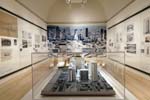 (Michel Legendre © Canadian Centre for Architecture, Montréal) CCA gallery view: The 60s: Montréal Thinks Big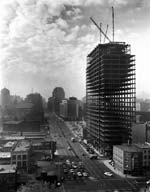 (© Archives Hydro-Québec) Hydro-Québec Headquarters Building under construction, October 1960; Gaston Gagnier, architect; Studio Jac-Guy, photographer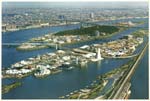 (Collection Canadian Centre for Architecture, Montréal, fonds André Blouin © Gordon F. Callaghan) Greeting Card with aerial view of the Expo 67 Islands; Gordon F. Callaghan, photographer, 1967 (© Ville de Montréal, Service de la mise en valeur du territoire et du patrimoine) Ville Marie Expressway, Study for section C next to Place d’Armes, September 1968; City of Montréal, City Planning Department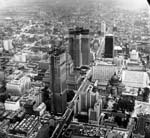 (Archives Nationales du Canada © The Gazette) Aerial view of downtown Montréal: Place Ville-Marie and CIBC building are under construction, August 7, 1961; Gar Lunney, photographer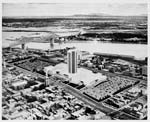 (Archives Radio-Canada) Aerial view photomontage: model and site of Maison Radio Canada, August 1963; unknown photographer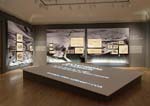 (Michel Legendre © Canadian Centre for Architecture, Montréal) CCA gallery view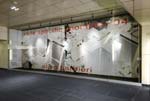 (Michel Legendre © Canadian Centre for Architecture, Montréal) CCA Extra-Muros: “Site Specific_Montréal 04” by Olivo Barbieri |
© 2005 ArchNewsNow.com